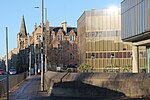Pollock Halls of Residence

Pollock Halls of Residence is the largest halls of residence for the University of Edinburgh, located at the foot of Arthur's Seat in Edinburgh, Scotland. The complex of buildings houses more than 2,000 undergraduate students during term time, and is available to the public as bed and breakfast-style accommodation outside of the teaching term. While some of the buildings date from the 19th century, the majority of Pollock Halls dates from the 1960s and early 2000s. Pollock Halls are located on the edge of Holyrood Park, 1+1⁄4 miles (2.0 km) southeast of the centre of Edinburgh, and 3⁄4 mile (1.2 km) from the university's central area around George Square.
Excerpt from the Wikipedia article Pollock Halls of Residence (License: CC BY-SA 3.0, Authors, Images).Pollock Halls of Residence
Holyrood Park Road, City of Edinburgh Southside
Geographical coordinates (GPS) Address Website Nearby Places Show on map
Geographical coordinates (GPS)
| Latitude | Longitude |
|---|---|
| N 55.939347222222 ° | E -3.1697305555556 ° |
Address
John McIntyre Conference Centre
Holyrood Park Road 18
EH16 5AY City of Edinburgh, Southside
Scotland, United Kingdom
Open on Google Maps










